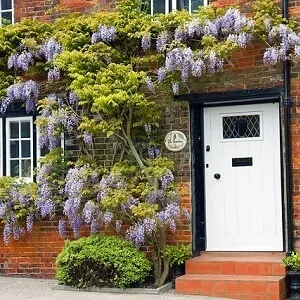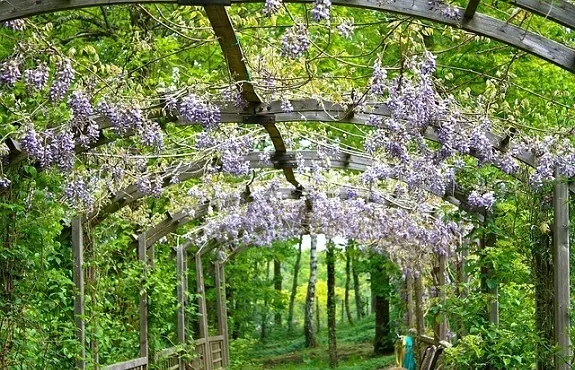 The wisteria plant has very impressive blooms that smell really sweet in springtime. Growing wisteria in pots can be very rewarding, allowing you to enjoy their stunning blooms and fragrant flowers even in limited spaces. The larger the planter the better it will grow and less maintenance it will require. Here’s how to successfully cultivate and train wisteria in containers.
The wisteria plant has very impressive blooms that smell really sweet in springtime. Growing wisteria in pots can be very rewarding, allowing you to enjoy their stunning blooms and fragrant flowers even in limited spaces. The larger the planter the better it will grow and less maintenance it will require. Here’s how to successfully cultivate and train wisteria in containers.
Selecting the Right Wisteria
Choose a suitable variety for pot cultivation, such as Japanese wisteria (Wisteria floribunda) or Chinese wisteria (Wisteria sinensis). These species are vigorous and can be trained to grow as a standard or small tree, making them ideal for pot growth.
Potting and Soil
- Container Size: Start with a pot that is slightly larger than the original container. Ideally, use a pot that is at least 70-75 litres in size for mature plants.
- Soil: Use a well-draining potting mix that retains moisture without becoming soggy. You can enhance drainage by adding perlite or sand to the mix.
Planting Instructions
- Planting Depth: When transferring your wisteria to a pot, plant it at the same depth as it was in its original container. Water it thoroughly after planting.
- Support Structure: Install a sturdy stake or trellis at the time of planting. This will help support the wisteria as it grows and allows you to train the stem upwards.
Care and Maintenance
- Location: Place your potted wisteria in a spot that receives full sun, ideally 6-8 hours of direct sunlight daily. This is crucial for promoting blooming.
- Watering: Wisteria requires consistent moisture. Check the soil regularly and water when the top inch feels dry. Avoid letting the soil dry out completely.
- Fertilizing: Feed your wisteria in spring with a low-nitrogen fertilizer, such as a general-purpose fertilizer with a ratio like 5-10-5. This helps prevent excessive leaf growth at the expense of flowers.
- Pruning: Prune your wisteria in late winter or early spring to shape the plant and encourage flowering. For young plants, trim back shoots to about a foot long each winter. Regular pruning is essential to maintain size and promote blooming.
Training for the Perfect Shape
- Choose a Strong Support: Select a sturdy support structure, such as a metal stake or trellis, that can withstand the weight of the mature plant. The support should be at least 6 feet tall to allow for upward growth before spreading out horizontally.
- Select the Leader: From the initial shoots, choose one strong leader shoot to train up the support. Remove all other shoots to focus the plant’s energy on this single stem.
- Wrap the Leader: As the leader grows, gently wrap it around the support. If it begins to twine around itself or the support, carefully untwist it and secure it back using soft ties to avoid damage.
- Encourage Side Growth: Once the leader reaches the desired height, allow lateral branches to develop. Choose a few strong side shoots to train horizontally along the support or to form a fan shape.
Pruning for Shape
- Regular Pruning: Prune your wisteria twice a year—once in summer (July or August) and again in winter (January or February). In summer, cut back long shoots to promote bushier growth. In winter, remove any dead or unwanted growth and shape the plant by shortening the remaining stems to encourage flowering.
- Focus on Flower Buds: During pruning, leave a few buds on each stem to ensure flowering. This helps concentrate the plant’s energy on producing blooms rather than excessive foliage.
- Maintain Structure: As the wisteria matures, continue to monitor its growth. Ensure that the main stem remains upright and that side branches are well-distributed to maintain an attractive shape.

Additional Tips
- Mulching: In autumn, apply a layer of organic mulch to help retain moisture and protect the roots during colder months.
- Winter Protection: In colder climates, consider covering the pot with horticultural fleece to protect the roots from frost.
By following these guidelines for growing and training wisteria in pots, you can cultivate a beautifully shaped plant that will thrive and bring joy to your garden for years to come. Enjoy the process and the stunning results!



Hello! I would love to grow a wisteria along a pergola we have just had built, however we live on King Island (Tasmania) and our Soil is sand! Would this plant still grow in this. It gets pretty windy down here as well.Would keeping it in a pot and training it to go up to the pergola roof sound possible. Could you give any suggestions please.
Thanking you Colleen O’Flaherty
Hello Colleen! Growing wisteria on your pergola in King Island, Tasmania is certainly possible, but you’ll need to take some special precautions given your sandy soil and windy conditions. Here’s how you can approach this:
Growing Wisteria in Sandy Soil
While wisteria prefers well-draining soil, extremely sandy soil can be challenging. To improve your soil conditions:
1. Amend the soil with organic matter like compost or well-rotted manure to improve water retention and nutrient content.
2. Add a layer of mulch around the base of the plant to help retain moisture.
3. Water more frequently, especially during dry periods, as sandy soil drains quickly.
Dealing with Wind
Wisteria can be susceptible to wind damage, especially when in bloom. To protect your plant:
1. Choose a wind-resistant variety like Japanese wisteria (Wisteria floribunda), which tends to be hardier.
2. Provide a sturdy support structure for the wisteria to climb on.
3. Consider planting a windbreak or using temporary screens during the windiest seasons.
Additional Suggestions
1. Start with a grafted plant rather than one grown from seed, as these tend to flower more reliably and earlier.
2. Prune regularly (twice a year) to control growth and encourage flowering.
3. Protect young plants from frost in winter, especially if grown in pots.
4. Be patient – it may take a few years for your wisteria to become established and start flowering profusely.
By following these guidelines, you should be able to successfully grow a beautiful wisteria on your pergola, even in the challenging conditions of King Island. Good luck with your gardening project!
Hi there,
I’m looking at growing a wisteria over a pergola for shade in summer.
My concern is it’s near water pipes and pool.
Would appreciate your thoughts.
Maureen x
Hi Maureen. Growing wisteria over a pergola for shade is a lovely idea, but there are some important considerations, especially since it’s near water pipes and a pool.
Key Considerations
1. Root Behavior: Wisteria has strong roots that can seek out moisture, which means they may be attracted to nearby water pipes. It’s advisable to avoid planting wisteria close to old or damaged pipes, as the roots could infiltrate and cause leaks or damage. If the pipes are in good condition, monitor them regularly for any signs of leakage.
2. Planting Options: Given your concerns, consider growing wisteria in a large pot. This allows you to control its root growth and prevents it from spreading towards the pipes. Use a pot that is at least 60 cm wide and ensure it has good drainage.
3. Training the Plant: Train the wisteria to climb the pergola by tying it to sturdy supports as it grows. Regular pruning (twice a year) will help manage its size and encourage flowering, while also keeping it from becoming too heavy for the pergola.
4. Soil and Watering: Wisteria prefers well-drained soil. If your soil is sandy, amend it with organic matter to improve moisture retention. Water the plant regularly, especially in the first few years as it establishes itself.
5. Wind Protection: If your area is windy, ensure the pergola is sturdy enough to support the wisteria and consider planting a windbreak nearby to protect it from strong gusts.
By following these guidelines, you can successfully grow wisteria over your pergola while minimizing risks to your water pipes and pool. Enjoy your gardening!
presumably over time the pot will fill with roots. what do you do then?
Hi Despina. Yes, the roots will eventually fill the pot, preventing the plant from growing larger. However, it can remain healthy in this container for many years. If you desire a larger plant, repot it into a bigger pot.